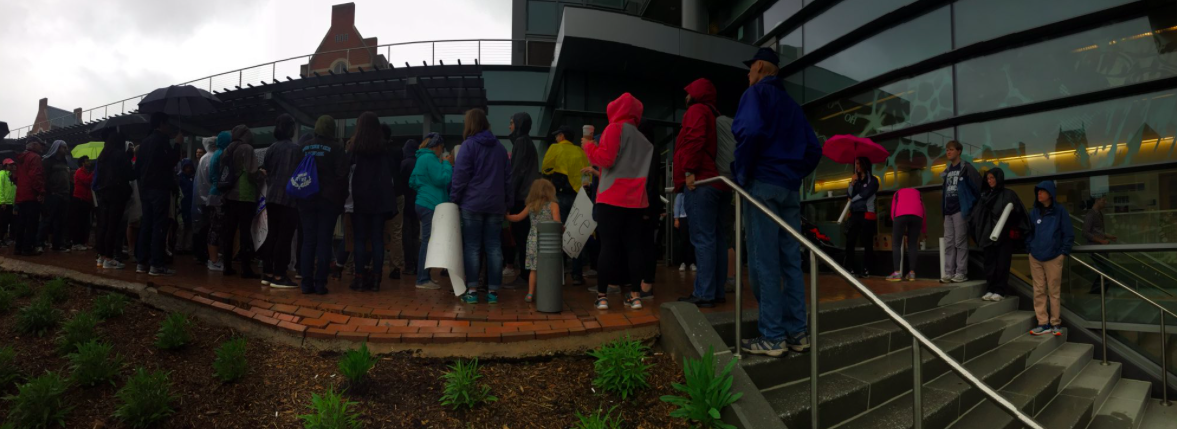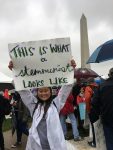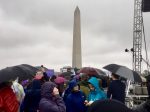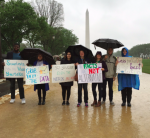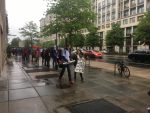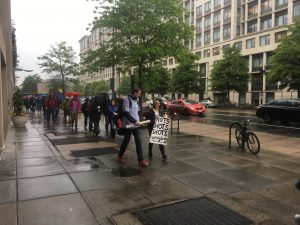“What do we want? Science! When do we want it? After peer review!”
The chant carried across the National Mall as a crowd of Hoyas marched past the Washington Monument. Despite the rain that threatened to smudge the carefully constructed slogans and designs on their poster boards, more than 200 students, faculty and staff gathered on Earth Day, April 22 for the March for Science. The march, inspired by widespread concerns over the state of science in public life and public policy, was a worldwide event to celebrate and defend the discipline. The Georgetown group that marched on Capitol Hill joined almost 15,000 other marchers in D.C., as well as tens of thousands of participants in satellite marches across the world, from Los Angeles to Antarctica.
Heidi Elmendorf, director of undergraduate students and studies in the biology department, and student volunteers began organizing the group after the march was announced in late January. Samantha Menegas (NHS ‘19), one of the student organizers, said Elmendorf encouraged participants to bring friends from outside Georgetown’s science community, in an effort to promote a multidisciplinary presence at the event.
Elmendorf commented that this effort was part of a push for widespread participation. “The march rebranded itself early on,” she said. “The initial name for it was ‘The Scientists’ March,’ and it rebranded itself as the ‘March for Science,’ and I think that shift is important.”
Concerns about the Trump administration’s budget cuts to scientific research institutions like the National Institutes of Health and the National Oceanic and Atmospheric Administration, as well as his cabinet picks for the Department of Energy and the Environmental Protection Agency, galvanized many of the protesters. Emily Mendenhall, a professor of global health in the Science, Technology, and International Affairs program, criticized the Trump administration’s disregard for scientific input in policymaking.
“Actually getting services to people, and distributing the science that we work hard on every day, it requires justice. It requires people who are committed to populations and committed to their people,” Mendenhall said. “This administration isn’t demonstrating that, so we’re marching.”
However, the organizers of the event maintain that it was not intended to be partisan. Participants hoped to encourage policymakers on all sides of the political spectrum to look to science when designing new laws, systems, and regulations. Critics of the march still assert that the movement has become overly politicized. They maintain that scientists should avoid partisanship and promote political objectivity. Robert Young, writing in a New York Times op-ed, argued that the march was well-intentioned, yet flawed because of its politically charged nature.
“Among scientists, understandably, there is growing fear that fact-based decision making is losing its seat at the policy-making table,” Young wrote. “But trying to recreate the pointedly political Women’s March will serve only to reinforce the narrative from skeptical conservatives that scientists are an interest group and politicize their data, research and findings for their own ends.”
In response to these objections, many Georgetown marchers deny that their goals claimed science for a single political party. While they agree that the march was meant to inspire science supporters into political action, they also state it was not intended to encourage partisan action.
“I think a lot of people had this idea that the march is a liberal march, it’s a march for liberals, it’s an anti-Trump march and you’re using science as an excuse to do it,” said Agnes Donnelly (COL ‘19), one of the student organizers of the Georgetown group. “I personally lean towards conservatism, but I participated in the march. Whether you are a Democrat or a Republican, you are going to be affected by science.”
- Photo: Anna Branedle
- Photo: Isaiah Seibert
- Photo: Isaiah Seibert
- Photo: Isaiah Seibert
- Courtesy of the Warren Lab
- Photo: Isaiah Seibert
Capitalizing on the march’s political momentum, Jane Donnelly (COL ‘19) said that Georgetown faculty and students are hoping to and encourage the integration of science education and literacy within the university. Although Georgetown’s reputation has historically centered around the humanities, new curriculum requirements and classes may steer students towards a more science-heavy course load.
There is already strong support among faculty and administrators for a science requirement in the SFS, a school jokingly referred to as “Safe From Science.” Elmendorf said that while science majors have always received excellent opportunities at the university, students who major in other disciplines often miss out on important scientific perspectives. She hopes that these stricter proposed science requirements for all undergraduates will help to expose students to scientific thought processes.
“I think one of the things that we’re trying to do more consistently is to offer students opportunities to encounter issues where science and society intersect and encounter them within the curriculum,” Elmendorf said.
The push to promote students’ science literacy is not just coming from science departments. Andrew Bennett, a professor in the government department, advised the foundation of the new Students for Climate Security group after the presidential election, and has moderated several panels on the future of science and policy in recent weeks. Bennett wrote in an email to the Voice that he hopes that developing this kind of scientific literacy in students will help them understand the extensive processes that aim to protect science against partial research or conclusions inclined towards political goals.
“At the same time, I think they should know that scientists are the first to agree that we need to work together to ensure that science embodies our values,” Bennett wrote. “Technologies — artificial intelligence, cloning, robotics — are creating social and economic challenges and ethical dilemmas that only political processes, informed by the best science, can address.”
Menegas, Jane Donnelly, Agnes Donnelly, and Julia Bevilacqua (COL ‘19) are in the process of forming a new science advocacy group on campus which they said will aim to make science more accessible to students who do not typically encounter scientific research in their studies. But just as they hope that others will take the time to learn more about scientific disciplines, Agnes Donnelly warns that it is also important for scientists to look outside their labs for learning opportunities.
“It’s important that, moving forward, with the science advocacy thing, that this doesn’t seem like a one-way street where we’re trying to push science on everyone,” Donnelly said. “I think that if we really want to look at the intersection of science and policy, science and business, science and fill-in-the-blank, hopefully, by extension, we as scientists will learn more about those fields, just as those fields are learning more about science.”
For students and faculty, their participation in the march was an energetic display of their determination to engage Georgetown in the intensifying national conversation on science. Yet their seven-mile march was just the first step in the effort to fully integrate science and society at the university, in D.C., and throughout the world.
Featured Photo Courtesy of the Warren Lab.


